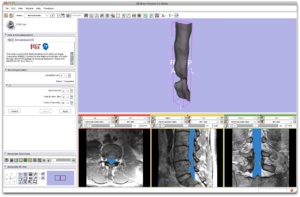Modules:SpineSegmentation-Documentation-3.6
Return to Slicer 3.6 Documentation
Module Name
SpineSegmentation module for Slicer 3.6
General Information
Module Type & Category
Type: Interactive or CLI
Category: Segmentation
Authors, Collaborators & Contact
- Sylvain Jaume: MIT CSAIL
- Contact: sylvain at csail.mit.edu
Module Description
Image segmentation of the spinal cord and the cerebro-spinal fluid in T2-weighted MRI images. The SpineSegmentation module implements a model-based pattern recognition algorithm for fully automated segmentation.
Usage
Use Cases, Examples
This module is especially appropriate for this use case:
- Automated segmentation of MRI of the spine is critical during minimally invasive intervention when frequent acquisitions of intra-operative images prevents the manual segmentation of the image by an expert. The SpineSegmentation module provides a solution to reduce the burden on the radiologist.
Examples of the module in use:
- Image-guided surgery for the treatment of disk herniation
Tutorial
- Sample Data Set
The sample data sets MRI_Spine.mhd and MRI_Spine.zraw are available at the link below. You will need to create a username on http://nitrc.org. Then log onto nitrc.org and click on the link below. Right-click on MRI_Spine.mhd and MRI_Spine.zraw to copy those files to your local directory.
http://www.nitrc.org/plugins/scmsvn/viewcvs.php/Slicer3/Modules/SpineSegmentation/TestingData/?root=sylvainproject
Below are the step-by-step instructions to load, process and save some sample data (see link above).
Step 1.
|
Load the sample data |
Step 2/9.
|
Select the SpineSegmentation module. |
Step 3/9.
|
Select the input image. |
Step 4/9.
|
Create a Slicer node for the output image. |
Step 5/9.
|
Create a Slicer node for the output model |
- Step 6/9.
|
Apply the segmentation algorithm |
- Step 7/9.
|
Review segmentation result. The sliders on the top of each 2D view allows for reviewing the segmentation result overlaid on the input image. |
- Step 8/9.
|
Save result image and model. The output image and the 3D model can be saved using the Slicer user interface. |
- Step 9/9.
|
Find contact information for help and paper reference |
Quick Tour of Features and Use
- Input panel:
- Image input select the input image
- Image output create Slicer node for output image
- Model output create Slicer node for output model
- Command panel:
- Default reset input and output nodes to blank values
- Cancel cancel the execution of the algorithm
- Apply apply the segmentation algorithm (takes approx. 3 min)
Development
Notes from the Developer(s)
Algorithms used, library classes depended upon, use cases, etc.
Dependencies
Other modules or packages that are required for this module's use.
Tests
On the Dashboard, these tests verify that the module is working on various platforms:
- MyModuleTest1 MyModuleTest1.cxx
- MyModuleTest2 MyModuleTest2.cxx
Known bugs
Links to known bugs in the Slicer3 bug tracker
Usability issues
Follow this link to the Slicer3 bug tracker. Please select the usability issue category when browsing or contributing.
Source code & documentation
SpineSegmentation's source code:
Slicer's Doxygen documentation:
More Information
Acknowledgment
This work is part of the National Alliance for Medical Image Computing (NAMIC), funded by the National Institutes of Health through the NIH Roadmap for Medical Research, Grant U54 EB005149 (PI: Ron Kikinis).
References
Stochastic Neurography, S. Jaume, M. Loepprich, E.J. Schmidt, R. Kikinis, 16th Annual Meeting of the Organization for Human Brain Mapping (HBM 2010), Barcelona, Spain, June 6-10, 2010.











